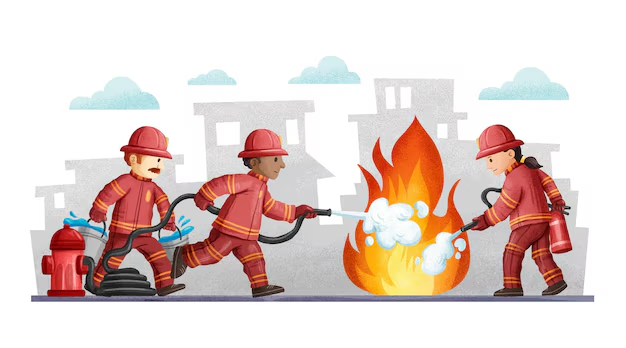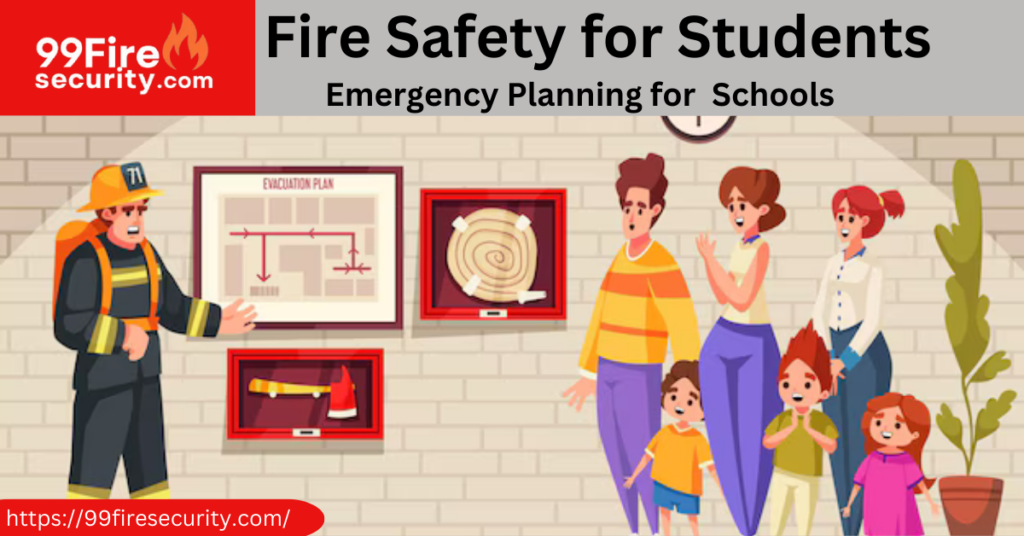One of the most important concerns for student safety. Fires can happen at any moment. It is critical for schools to have a thorough emergency action plan to protect the safety of all students’ staff and guests. Fire safety emergency planning may include established evacuation procedures, fire drills, staff training, and maintenance of fire safety systems. The key elements of emergency planning for fire safety emergencies in school. Compel layout with no work around.
1. Developing a Fire Safety Plan
The Importance of Having a Fire Safety Plan
A fire safety plan is simply a plan that outlines the procedures used to respond to a fire emergency. Every school, regardless of size, must have a fire safety plan. That plan must be implemented in such a way as to maintain the safety of students, staff and visitors. at the same time prevent injury or loss of life.
Essential Components of a Fire Safety Plan
Evacuation Routes and Exits: Outline and map primary and secondary routes for evacuation. All exits must be clearly marked and easily accessible.
Assembly Points: Identify safe meeting points away from the building for everyone to gather after leaving. Make sure everyone knows where these jumps are.
Fire Safety Equipment: Know where fire extinguishers, smoke alarms, fire alarms and emergency exits are located. Equipment should be in working condition.
Staff and Students Participating in the Plan
Once the plan has been developed it’s important for all staff and students. to know what they’ll need to do in the event of a fire. That includes understanding the evacuation routes. How to operate fire safety equipment and where to go once they’re out of the building.
2. Routine Fire Drills and Practice
Why Fire Drills Are Important
Fire drills optimize students and staff familiarity with maximum evacuation. These drills are important so that everyone knows what to do if there is a real emergency. Frequent fire drills develop muscle memory, minimize panic and guarantee that evacuations can be done swiftly and effectively.
How Regularly Should We Hold Fire Drills?
Fire drills must be held at least every semester ‘Although many schools hold them more often. Conducted during various times of day, drills ensure the response is effective no matter the circumstance.
Simulating Our Real Life Scenarios
This will be helpful to vary the fire drill scenario periodically. For example, pretend there’s a fire that breaks out in a hallway, a classroom or the cafeteria. This ensures that students and staff alike have practice evacuating from different areas of the building in case of ever needing to do so.
3. Staff and Students Training
Teacher and Staff Training
All school staff members — from teachers to administrators to custodians — must be trained on fire safety protocols. In particular, such training should help judges learn how to.
- Lead students to safety.
- Make use of fire extinguishers and other safety equipment.
- Help special needs students.
- Take roll and make sure everybody is present.
- Contact emergency response agencies.
Training must take place at least annually and whenever there are updates or changes to fire safety practices.
Student Fire Safety Education
Age-appropriate education on fire safety is essential for students. This education can include.
- Fire Safety Basics: These include the dangers of fire, how to spot a fire hazard, and the importance of fire safety tools.
- Evacuation Procedures: Discuss evacuation routes and assembly points, along with what to do during a fire drill.
- Safety Behavior: Reinforce positive safe behaviors in classrooms and on school grounds. Such as not playing with fire or blocking exits.
A proactive response would be designing and implementing a fire safety program into the school curriculum this embeds the fire service within the school and makes fire safety a priority and not just a one-off event.
4. Maintenance of Fire Safety Equipment
Title: Significance of Fire Safety Appliances
Fire safety equipment is essential to prevent injuries and fatalities in the event of a fire. Schools are also required to have their fire safety equipment checked. maintained regularly to ensure it works.
Important Fire Safety Equipment for Schools
Fire Extinguishers — adequately stocked with types for potential response (i.e., Class A for clean fuels, Class C for electrical).
- Smoke Alarms and Fire Alarms: Conduct a monthly test of smoke detectors and fire alarms to confirm they are in working order. Ensure these are in high-traffic places like hallways, classrooms and cafeterias.
- Emergency Lighting: Make sure you have emergency lights that work and especially near exit doors or stairways. Help people reach safety during a fire mesh and if the power goes out.
Regular Inspection
Fire gear needs to be serviced periodically, and all faulty and expired equipment should be replaced as soon as possible. That includes making sure that the equipment is accessible. That staff members know how to operate it during an emergency.
Emergency Alerts & Notifications
Accurate and timely communication about a fire helps ensure that everyone knows about the risk and can react accordingly to escape and seek safety. Schools should have a dependable communication protocol in place that can notify individuals on campus in the case of a fire.
Role of Teachers and Staff
Prepare teachers and staff to pass information to students and others in a fire emergency. This includes:
- Aiding students to evacuate without panic and quickly.
- Making sure students don’t ride an elevator during a fire.
- Accurate attendance records for emergency responders once outside.
- Additional Considerations for Students with Disabilities
Accessible Evacuation Plans
They need to be sure that their evacuation plans meet the needs of students with disabilities. This may include.
- Having staff members to help students with mobility issues evacuate.
- You have accessible routes and exits for wheelchairs.
- The staff trained to assist students with hearing or vision loss.
- The page you requested could not be found.
Depending on the layout of the space and the number of students who may need egress assistance. Special evacuation devices (e.g., evacuation chairs) may be required to assist students who are unable to navigate stairs. Make sure these devices are on hand. Staff is trained on how to use them.

Fire Preparedness: What to Do When Returning Home after the Fire
Conducting Roll Call
As part of the protocol teachers have to immediately account for all students after evacuating the building. This may mean checking attendance lists. Requesting some sort of electronic system if which is available. If any students are unaccounted for, this must be reported to emergency responders as soon as possible.
Conclusion
Fire safety in schools is a collective effort — one that involves planning, periodic drills, continual education and the proper equipment. If there is a well-designed emergency plan in place combined with regular fire drills, coupled with proper training for both staff and students; then the risk of fire-related disasters is minimal. Student safety is the No. 1 priority, and it is critical to make fire safety a priority at all times.
FAQs
For more information, please visit.
Fire drills must be held once each semester, but many schools do fire drills above that, so they’re ready when (hopefully never) the time comes.
What goes into a school’s fire safety plan?
Evacuation routes, assembly points, designated emergency staff members, fire safety equipment and access procedures for students with disabilities should all be incorporated into a school’s fire safety plan.
Who is responsible for maintaining fire safety equipment in schools?
As the owner/operator of the building, it is the responsibility of the school administration to have all the fire safety equipment regularly maintained and inspected.
How can schools teach students about fire safety?
Fire safety lessons should be part of the school curriculum, and schools can also hold workshops, and students should participate in fire drills to get familiarized with evacuation procedures.
What can a teacher do during a fire drill that is not going well?
If a fire drill is not going well, teachers need to stay calm, keep leading their students to safety and report issues to the school administration so that they can be addressed in future drills.


